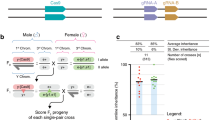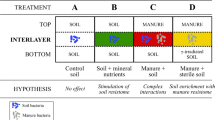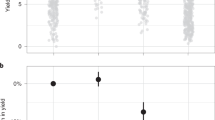Abstract
Transgenic crops are approved for release in some countries, while many more countries are wrestling with the issue of how to conduct risk assessments. Controls on field trials often include monitoring of horizontal gene transfer (HGT) from crops to surrounding soil microorganisms. Our analysis of antibiotic-resistant bacteria and of the sensitivity of current techniques for monitoring HGT from transgenic plants to soil microorganisms has two major implications for field trial assessments of transgenic crops: first, HGT from transgenic plants to microbes could still have an environmental impact at a frequency approximately a trillion times lower than the current risk assessment literature estimates the frequency to be; and second, current methods of environmental sampling to capture genes or traits in a recombinant are too insensitive for monitoring evolution by HGT. A model for HGT involving iterative short-patch events explains how HGT can occur at high frequencies but be detected at extremely low frequencies.
This is a preview of subscription content, access via your institution
Access options
Subscribe to this journal
Receive 12 print issues and online access
$209.00 per year
only $17.42 per issue
Buy this article
- Purchase on Springer Link
- Instant access to full article PDF
Prices may be subject to local taxes which are calculated during checkout


Similar content being viewed by others
References
Harremoës, P. et al. (eds.) Late Lessons from Early Warnings: the Precautionary Principle, 1896–2000 Environmental Issue Report No. 22 (Official Publications of the European Communities, Copenhagen, 2002).
Traavik, T. Environmental risks of genetically engineered vaccines. in Genetically Engineered Organisms Assessing Environmental and Human Health Effects (eds. Letourneau, D.K. & Burrows, B.E.) 331–353 (CRC Press, Boca Raton, 2002).
Conner, A.J., Glare, T.R. & Nap, J.-P. The release of genetically modified crops into the environment Part II. Overview of ecological risk assessment. Plant J. 33, 19–46 (2003).
Gasson, M. & Burke, D. Scientific perspectives on regulating the safety of genetically modified foods. Nat. Rev. Genet. 2, 217–222 (2001).
Amábile-Cuevas, C.F. (ed.) Multiple Drug Resistant Bacteria (Horizon Scientific Press, Wymondham, 2003).
Anonymous. Report of the ASM task Force on Antibiotic Resistance. Antimicrob. Agents Chemother. 39, 2–23 (1995).
de la Cruz, F., Garcia-Lobo, J.M. & Davies, J. Antibiotic resistance: how bacterial populations respond to a simple evolutionary force. in Bacterial Resistance to Antimicrobials (eds. Lewis, K., Salyers, A.A., Taber, H.W. & Wax, R.G.) 19–36 (Marcel Dekker, New York and Basel, 2002).
Heinemann, J.A. How antibiotics cause antibiotic resistance. Drug Discov. Today 4, 72–79 (1999).
Levy, S.B. The challenge of antibiotic resistance. Sci. Amer. 278, 32–39 (1998).
Springael, D. & Top, E.M. Horizontal gene transfer and microbial adaptation to xenobiotics: new types of mobile genetic elements and lessons from ecological studies. Trends Microbiol. 12, 53–58 (2004).
Jain, R., Rivera, M.C. & Lake, J.A. Horizontal gene transfer among genomes: the complexity hypothesis. Proc. Natl. Acad. Sci. USA 96, 3801–3806 (1999).
Lawrence, J.G. & Roth, J.R. Selfish operons: horizontal transfer may drive the evolution of gene clusters. Genetics 143, 1843–1860 (1996).
Ochman, H., Lawrence, J.G. & Groisman, E.A. Lateral gene transfer and the nature of bacterial innovation. Nature 405, 299–304 (2000).
Rujan, R. & Martin, W. How many genes in Arabidopsis come from cyanobacteria? An estimate from 386 protein phylogenies. Trends Genet. 17, 113–120 (2001).
Syvanen, M. & Kado, C.I. (eds.) Horizontal Gene Transfer edn. 2 (Academic Press, San Diego, 2002).
Woese, C.R. On the evolution of cells. Proc. Natl. Acad. Sci. USA 99, 8742–8747 (2002).
de Vries, J., Heine, M., Harms, K. & Wackernagel, W. Spread of recombinant DNA by roots and pollen of transgenic potato plants, identified by highly specific biomonitoring using natural transformation of an Acinetobacter sp. Appl. Environ. Microbiol. 69, 4455–4462 (2003).
Nielsen, K.M., Bones, A.M., Smalla, K. & van Elas, J.D. Horizontal gene transfer from transgenic plants to terrestrial bacteria—a rare event? FEMS Microbiol. Rev. 22, 79–103 (1998).
Nielsen, K.M., van Elas, J.D. & Smalla, K. Transformation of Acinetobacter sp. strain BD413(pFG4DnptII) with transgenic plant DNA in soil microcosms and effects of kanamycin on selection of transformants. Appl. Environ. Microbiol. 66, 1237–1242 (2000).
Kay, E., Vogel, T.M., Bertolla, F., Nalin, R. & Simonet, P. In situ transfer of antibiotic resistance genes from transgenic (transplastomic) tobacco plants to bacteria. Appl. Environ. Microbiol. 68, 3345–3351 (2002).
Tepfer, D. et al. Homology-dependent DNA transfer from plants to a soil bacterium under laboratory conditions: implications in evolution and horizontal gene transfer. Trans. Res. 12, 425–437 (2003).
Schluter, K., Futterer, J. & Potrykus, I. 'Horizontal' gene transfer from a transgenic potato line to a bacterial pathogen (Erwinia chrysanthemi) occurs—if at all—at an extremely low frequency. Bio/Technology 13, 1094–1098 (1995).
Massova, I. & Mobashery, S. Kinship and diversification of bacterial penicillin-binding proteins and beta-lactamases. Antimicrob. Agents Chemother. 42, 1–17 (1998).
Hakenbeck, R., Grebe, T., Zähner, D. & Stock, J.B. β-lactam resistance in Streptococcus pneumoniae: penicillin-binding proteins and non-penicillin-binding proteins. Mol. Microbiol. 33, 673–678 (1999).
Spratt, B.G. Resistance to antibiotics mediated by target alterations. Science 264, 388–393 (1994).
Walsh, C. Antibiotics Actions Origins Resistance (ASM Press, Washington, 2003).
Nichol, K.A., Zhanel, G.G. & Hoban, D.J. Penicillin-binding protein 1A, 2B, and 2X alterations in Canadian isolates of penicillin-resistant Streptococcus pneumoniae. Antimicrob. Agents Chemother. 46, 3261–3264 (2002).
Hooper, D.C. in Bacterial Resistance to Antimicrobials (eds. Lewis, K. Salyers, A.A., Taber, H.W. & Wax, R.G.) 161–192 (Marcel Dekker, New York, 2002).
Amoroso, A., Demares, D., Mollerach, M., Gutkind, G. & Coyette, J. All detectable high-molecular-mass penicillin-binding proteins are modified in a high-level β-lactam-resistant clinical isolate of Streptococcus mitis. Antimicrob. Agents Chemother. 45, 2075–2081 (2001).
Claverys, J.-P., Prudhomme, M.I.M.-B. & Martin, B. Adaptation to the environment: Streptococcus pneumoniae, a paradigm for recombination-mediated genetic plasticity? Mol. Microbiol. 35, 251–259 (2000).
Heinemann, J.A. Horizontal gene transfer between microorganisms. in Encyclopedia of Microbiology edn. 2 (ed. Lederberg, J.) 698–706 (Academic Press, San Diego, 2000).
Marvier, M. Ecology of transgenic crops. Am. Sci. 89, 160–167 (2001).
Doern, G.V. et al. Antimicrobial resistance among clinical isolates of Streptococcus pneumoniae in the United States during 1999–2000, including a comparison of resistance rates since 1994–1995. Antimicrob. Agents Chemother. 45, 1721–1729 (2001).
Molbak, L., Licht, T.R., Kvist, T., Kroer, N. & Andersen, S.R. Plasmid transfer from Pseudomonas putida to the indigenous bacteria on alfalfa sprouts: characterization, direct quantification, and in situ location of transconjugant cells. Appl. Environ. Microbiol. 69, 5536–5542 (2003).
Lilley, A.K. et al. Population dynamics and gene transfer in genetically modified bacteria in a model microcosm. Mol. Ecol. 12, 3097–3107 (2003).
Anderson, E.S. The ecology of transferable drug resistance in the enterobacteria. Annu. Rev. Microbiol. 22, 131–180 (1968).
Heinemann, J.A., Ankenbauer, R.G. & Amábile-Cuevas, C.F. Do antibiotics maintain antibiotic resistance? Drug Discov. Today 5, 195–204 (2000).
du Plessis, M., Bingen, E. & Klugman, K.P. Analysis of penicillin-binding protein genes of clinical isolates of Streptococcus pneumoniae with reduced susceptibility to amoxicillin. Antimicrob. Agents Chemother. 46, 2349–2367 (2002).
Nielsen, K.M. et al. Natural transformation and availability of transforming DNA to Acinetobacter calcoaceticus in soil microcosms. Appl. Environ. Microbiol. 63, 1945–1952 (1997).
Gebhard, R. & Smalla, K. Transformation of Acinetobacter sp. strain BD413 by transgenic sugar beet DNA. Appl. Environ. Microbiol. 64, 1550–1554 (1998).
Mendelsohn, M., Kough, J., Vaituzis, Z. & Matthews, K. Are Bt crops safe? Nat. Biotechnol. 21, 1003–1009 (2003).
Majewski, J., Zawadzki, P., Pickerill, P., Cohan, F.M. & Dowson, C.G. Barriers to genetic exchange between bacterial species: Streptococcus pneumoniae transformation. J. Bacteriol. 182, 1016–1023 (2000).
Whitman, W.B., Coleman, D.C. & Wiebe, W.J. Prokaryotes: the unseen majority. Proc. Natl. Acad. Sci. USA 95, 6578–6583 (1998).
Stokstad, E. Monsanto pulls the plug on genetically modified wheat. Science 304, 1088–1089 (2004).
Knols, B.G.J. & Dicke, M. Bt crop risk assessment in the Netherlands. Nat. Biotechnol. 21, 973–974 (2003).
de Maagd, R.A., Bravo, A. & Crickmore, N. How Bacillus thuringiensis has evolved toxins to colonize the insect world. Trends Genet. 17, 193–199 (2001).
Saxena, D., Flores, S. & Stotzky, G. Insecticidal toxin in root exudates from Bt corn. Nature 402, 480 (1999).
Chowdhury, E.H. et al. Detection of corn intrinsic and recombinant DNA fragments and Cry1Ab protein in the gastrointestinal contents of pigs fed genetically modified corn Bt11. J. Anim. Sci. 81, 2546–2551 (2003).
Keeling, P.J. & Palmer, J.D. Lateral transfer at the gene and subgenic levels in the evolution of eukaryotic enolase. Proc. Natl. Acad. Sci. USA 98, 10745–10750 (2001).
Balsalobre, L., Ferrandiz, M.J., Linares, J., Tubau, F. & de la Campa, A.G. Viridans group streptococci are donors in horizontal transfer of topoisomerase IV genes to Streptococcus pneumoniae. Antimicrob. Agents Chemother. 47, 2072–2081 (2003).
Kuiper, H.A., Kleter, G.A., Noteborn, H.P.J.M. & Kok, E.J. Assessment of the food safety issues related to genetically modified foods. Plant J. 27, 503–528 (2001).
Curtis, T.P., Sloan, W.T. & Scannell, J.W. Estimating prokaryotic diversity and its limits. Proc. Natl. Acad. Sci. USA 99, 10494–10499 (2002).
Heinemann, J.A., Sparrow, A.D. & Traavik, T. Is confidence in monitoring of GE foods justified? Trends Biotechnol. 22, 331–336 (2004).
Sørensen, S.J., Sørensen, A.H., Hansen, L.H., Oregaard, G. & Veal, D. Direct detection and quantification of horizontal gene transfer by using flow cytometry and GFP as a reporter gene. Curr. Microbiol. 47, 129–133 (2003).
Michael, C. et al. Mobile gene cassettes: a fundamental resource for bacterial evolution. Am. Nat. 164, 1–12 (2004).
Nemergut, D.R., Martin, A.P. & Schmidt, S.K. Integron diversity in heavy-metal-contaminated mine tailings and inferences about integron evolution. Appl. Environ. Microbiol. 70, 1160–1168 (2004).
Stokes, H.W. et al. Gene cassette PCR: sequence-independent recovery of entire genes from environmental DNA. Appl. Environ. Microbiol. 67, 5240–5246 (2001).
Cooper, T.F. & Heinemann, J.A. Post-segregational killing does not increase plasmid stability but acts to mediate the exclusion of competing plasmids. Proc. Natl. Acad. Sci. USA 97, 12543–12648 (2000).
Doolittle, W.F. Phylogenetic classification and the universal tree (taxonomies based on molecular sequences). Science 284, 2124–2130 (1999).
Heinemann, J.A. Genetics of gene transfer between species. Trends Genet. 7, 181–185 (1991).
Maiden, M.C.J., Malorny, B. & Achtman, M. A global gene pool in the neisseriae. Mol. Microbiol. 21, 1297–1298 (1996).
Gibbs, M.J. & Weiller, G.F. Evidence that a plant virus switched hosts to infect a vertebrate and then recombined with a vertebrate-infecting virus. Proc. Natl. Acad. Sci. USA 96, 8022–8027 (1999).
Prudhomme, M., Libante, V. & Claverys, J.-P. Homologous recombination at the border: insertion-deletions and the trapping of foreign DNA in Streptococcus pneumoniae. Proc. Natl. Acad. Sci. USA 99, 2100–2105 (2002).
Denamur, E. et al. Evolutionary implications of the frequent horizontal transfer of mismatch repair genes. Cell 103, 711–721 (2000).
Evans, E. & Alani, E. Roles for mismatch repair factors in regulating genetic recombination. Mol. Cell. Biol. 20, 7839–7844 (2000).
Matic, I., Rayssiguier, C. & Radman, M. Interspecies gene exchange in bacteria: the role of SOS and mismatch repair systems in evolution of species. Cell 80, 507–515 (1995).
Rayssiguier, C., Thaler, D.S. & Radman, M. The barrier to recombination between Escherichia coli and Salmonella typhimurium is disrupted in mismatch-repair mutants. Nature 342, 396–401 (1989).
Cupples, C.G., Cabrera, M., Cruz, C. & Miller, J.H. A set of lacZ mutations in Escherichia coli that allow rapid detection of specific frameshift mutations. Genetics 125, 275–280 (1990).
Humayun, M.Z. SOS and Mayday: multiple inducible mutagenic pathways in Escherichia coli. Mol Microbiol 30, 905–910 (1998).
Mihaylova, V.T. et al. Decreased expression of the DNA mismatch repair gene Mlh1 under hypoxic stress in mammalian cells. Mol. Cell. Biol. 23, 3265–3273 (2003).
Amann, R., Ludwig, W. & Schleifer, K. Phylogenetic identification and in situ detection of individual microbial cells without cultivation. Microbiol. Rev. 59, 143–169 (1995).
Kaeberlein, T., Lewis, K. & Epstein, S.S. Isolating “uncultivable” microorganisms in pure culture in a simulated natural environment. Science 296, 1127–1129 (2002).
Acknowledgements
We thank C. Amábile-Cuevas, H. Cochrane, D. Bean and R. Mann for critical comments on the manuscript. J.A.H. acknowledges support from the Marsden Fund of New Zealand (M1042) and the Brian Mason Trust.
Author information
Authors and Affiliations
Corresponding author
Ethics declarations
Competing interests
The authors declare no competing financial interests.
Rights and permissions
About this article
Cite this article
Heinemann, J., Traavik, T. Problems in monitoring horizontal gene transfer in field trials of transgenic plants. Nat Biotechnol 22, 1105–1109 (2004). https://doi.org/10.1038/nbt1009
Published:
Issue Date:
DOI: https://doi.org/10.1038/nbt1009
This article is cited by
-
Identification and validation of the wound and insect bite early inducible promoter from Arabidopsis thaliana
3 Biotech (2022)
-
ptxD gene in combination with phosphite serves as a highly effective selection system to generate transgenic cotton (Gossypium hirsutum L.)
Plant Molecular Biology (2017)
-
Transgenic hybrid aspen overexpressing the Atwbc19 gene encoding an ATP-binding cassette transporter confers resistance to four aminoglycoside antibiotics
Plant Cell Reports (2010)
-
Development of real time PCR assays for detection and quantification of transgene DNA of a Bacillus thuringiensis (Bt) corn hybrid in soil samples
Transgenic Research (2010)
-
Transgene stability and dispersal in forest trees
Trees (2009)



